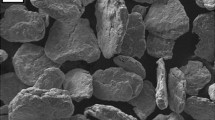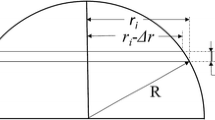One of the main tasks of steelmaking is to obtain the necessary thermodynamic conditions that ensure fine and homogeneous solidified microstructure. The relatively economical solution is to feed microadditives into liquid steel. The metallurgical considerations and techniques on the feeding of microadditives are described in the present work. The effect of small addition of reactive fine particles and ultra-high melting point powders on the control of non-metallic inclusions, slab center segregation, and mechanical properties, especially the Z-direction properties, was investigated. The results showed that the microadditives had composite effects on microalloying and modification of inclusions. The segregation of elements in the slab center of high strength steels was remarkably reduced. The mechanical property along the Z-direction of steel plates was greatly improved.






Similar content being viewed by others
References
Y. P. Ma, “Effect of compound modification on inclusion morphology and property of cast wear-resistant steel,” J. Iron Steel Res. Int., 14, 38 (2002).
Z. X. Xia, Z. Y. Yan, and J. Su, “Effect of morphology of MnS inclusions on impact toughness of ultra-high strength steel,” Mater. Sci. Technol., 17, 746 (2009).
R. Inoue, T. Ariyama, and H. Suito, “Thermodynamics of zirconium deoxidation equilibrium in liquid iron by EMF measurements,” ISIJ Int., 48, 1175 (2008).
I. Barin, Thermochemical Data of Pure Substances, Wiley-VCH, (2008), 3rd ed.
K. Yamamoto, T. Kasegawa, and J. Takamura, “Effect of boron on intra-granular ferrite formation in Ti-oxide bearing steels,” ISIJ Int., 36, 80 (1996).
F. F. Ji, “Variation of shape and character of nonmetallic inclusion in steel by adding rare-earth element,” Jinan Daxue Xuebao, Ziran Kexueban (Jinan, China), 17, 76 (2003).
L. D. Teng, F. M. Wang, and W. C. Li, “Thermodynamics and microstructure of Ti–ZrO2 metal–ceramic functionally graded materials,” Mater. Sci. Eng., A, 293, 130 (2000).
F. R. Xiao, B. Liao, Y. Y. Shan, et al., “Challenge of mechanical properties of an acicular ferrite pipeline steel,” Mater. Sci. Eng., A, 431, 41 (2006).
X. J. Zhuo, X. H. Wang, W. J. Wang, and H. G. Lee, “Thermodynamic calculations and experiments on inclusions to be nucleation sites for intragranular ferrite in Si–Mn–Ti deoxidized steel,” J. Univ. Sci. Technol. Beijing, 14, 14 (2007).
X. F. Wang and W. Q. Chen, “Influence of cerium on hot workability of 00Cr25Ni7Mo4N super duplex stainless steel,” J. Rare Earths, 28, 295 (2010).
B. Wen, B. Song, N. Pan, et al., “Infl uence of Ce on Characteristics of Inclusions and Microstructure of Pure Iron,” J. Iron Steel Res. Int., 18, 38 (2011).
X. Liu and J. C. Yang, “Effect of Ce on inclusions and impact property of 2Cr13 stainless steel,” J. Iron Steel Res. Int., 17, 59 (2010).
ISO 4967:1998(E), Steel-Determination of Content of Nonmetallic Inclusions-Micrographic Method Using Standards Diagrams (1998).
X. H. Huang, “Principle of Steel Metallurgy,” Metallurgical Industry Press, China (2013), 4th ed.
Factsage 6.1, www.factsage.cn.
K. J. He and T. N. Baker, “Zr-containing precipitates in a Ti–Nb microalloyed HSLA steel containing 0.016% wt.% Zr addition,” Mater. Sci. Eng., A, 215, 57 (1996).
Y. Li, X. L. Wan, L. Cheng, and K. M. Wu, “First-principles calculation of the interaction of Mn with ZrO2 and its effect on the formation of ferrite in high-strength low-alloy steels,” Scr. Mater., 75, 78 (2014).
Y. Li, X. L. Wan, L. Cheng, and K. M. Wu, “Effect of oxides on nucleation of ferrite: first-principles modeling and experimental approach,” Mater. Sci. Technol., DOI 10.1179/1743284715Y.0000000102.
T. Q. He, K. M. Wu, A. Trotsan, et al., “Effect of feeding Ca–Mg–RE–Zr composite cored wire during refining of liquid steel on abrasive wear resistance of high-strength steels,” Wear, 303, 524 (2013).
Acknowledgments
The authors gratefully acknowledge support from the International Science and Technology Corporation Program (No. 2011DFR51040) of the Ministry of Science and Technology, and from the International Science and Technology Corporation Program (No. 2015BHE008) of Hubei Province.
Author information
Authors and Affiliations
Rights and permissions
About this article
Cite this article
Hu, C., Wu, K., Trotsan, A. et al. Effect of Microadditives on Center Segregation and Mechanical Properties of High-Strength Low-Alloy Steels. Metallurgist 60, 888–895 (2016). https://doi.org/10.1007/s11015-016-0382-8
Published:
Issue Date:
DOI: https://doi.org/10.1007/s11015-016-0382-8




